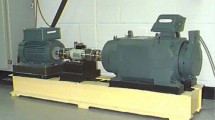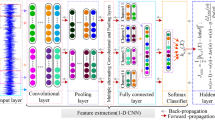Abstract
Deep-learning-based fault diagnosis of wind turbine has played a significant role in advancing the renewable energy industry. However, the imbalanced data sampled by the supervisory control and data acquisition systems has led to low diagnosis accuracy. Additionally, deep neural networks can encounter issues like gradient vanishing and insufficient feature learning during backpropagation when the model is too deep. This article introduces a novel approach that is based on dynamic weight loss functions to modulate unbalanced data and improve diagnostic accuracy by focusing on misclassification of a small sample number. The proposed approach employs a 1D-CNN model and an ensemble-learning-based convolution neural network (EL-CNN) to enhance diversity of models and complementarity of feature learning. The EL-CNN model addresses the problem of local features being overlooked and provides more accurate results. The effectiveness of this proposed approach is well demonstrated through experimental cases on real wind turbine pitch system fault data. Two different networks using three different loss functions and three state-of-the-art fault diagnosis models are tested, demonstrating the EL-CNN model’s superiority.













Similar content being viewed by others
Data Availability
The data that support the findings of this study are available from the corresponding author, C. Wen, upon reasonable request.
References
Dameshghi A, Refan MH. Wind turbine gearbox condition monitoring and fault diagnosis based on multi-sensor information fusion of SCADA and DSER-PSO-WRVM method. Int J Model Simul. 2018;39(1):48–72.
Qiao W, Lu D. A survey on wind turbine condition monitoring and fault diagnosis-Part II: Signals and signal processing methods. IEEE Trans Ind Electron. 2023;62(10):6546–57.
Zheng Y, Zhou W, Yang W, Liu L, Liu Y, Zhang Y. Multivariate/minor fault diagnosis with severity level based on Bayesian decision theory and multidimensional RBC. J Process Control. 2021;101:68–77.
Chen H, Jing S, Wang X, Wang Z. Fault diagnosis of wind turbine gearbox based on wavelet neural network. J Low Freq Noise Vib Act Control. 2018;37(4):977–86.
Jiang G, He H, Yan J, Xie P. Multiscale convolutional neural networks for fault diagnosis of wind turbine gearbox. IEEE Trans Ind Electron. 2019;66(4):3196–207.
Xu D, Liu PF, Chen ZP. Damage mode identification and singular signal detection of composite wind turbine blade using acoustic emission. Compos Struct. 2021;255:112954.
Schlechtingen M, Santos IF. Comparative analysis of neural network and regression based condition monitoring approaches for wind turbine fault detection. Mech Syst Signal Process. 2011;25(5):1849–75.
Attallah O, Ibrahim RA, Zakzouk NE. CAD system for inter-turn fault diagnosis of offshore wind turbines via multi-CNNs & feature selection. Renewable Energy. 2023;203:870–80.
Yu Y, Cao H, Yan X, Wang T, Ge SS. Defect identification of wind turbine blades based on defect semantic features with transfer feature extractor. Neurocomputing. 2020;376:1–9.
Li D, Zhao Y, Zhao Y. A dynamic-model-based fault diagnosis method for a wind turbine planetary gearbox using a deep learning network. Prot Control Mod Power Syst. 2022;7:22.
Cao J, Wang Y, Tao H, Guo X. Sensor-based human activity recognition using graph LSTM and multi-task classification model. ACM Trans Multimed Comput Commun Appl. 2022;18(3s):1–19.
Cao J, Bu Z, Wang Y, Yang H, Jiang J, Li H. Detecting prosumer-community group in smart grids from the multiagent perspective. IEEE Transactions on Systems Man Cybernetics: Systems. 2019;49(8):1652–64.
Dong Y, Wen C, Wang Z. A motor bearing fault diagnosis method based on multi-source data and one-dimensional lightweight convolution neural network. Proceedings of the Institution of Mechanical Engineers, Part I: Journal of Systems and Control Engineering. 2022;237(2):272–83.
Luo X, Wu H, Li Z. NeuLFT: A novel approach to nonlinear canonical polyadic decomposition on high-dimensional incomplete tensors. IEEE Trans Knowl Data Eng. 2023;35(6):6148–66.
Luo X, Zhou Y, Liu Z, Zhou MC. Fast and accurate non-negative latent factor analysis on high-dimensional and sparse matrices in recommender systems. IEEE Trans Knowl Data Eng. 2023;35(4):3897–911.
Wang Z, Wen C, Dong Y. A method for rolling bearing fault diagnosis based on GSC-MDRNN with multi-dimensional input. Meas Sci Technol 2023;(34):055901.
Zeng N, Wu P, Wang Z, Li H, Liu W, Liu X. A small-sized object detection oriented multi-scale feature fusion approach with application to defect detection. IEEE Trans Instrum Meas. 2022;(71):3507014.
Zou L, Li Y, Xu F. An adversarial denoising convolutional neural network for fault diagnosis of rotating machinery under noisy environment and limited sample size case. Neurocomputing. 2020;407:105–20.
Chen J, Hu W, Cao D, Zhang Z, Chen Z. A novel multi-task learning method with attention mechanism for wind turbine blades imbalance fault diagnosis, In: Proceedings of the 2022 4th Asia Energy and Electrical Engineering Symposium (AEEES), Chengdu, China. 2022;857–862.
Liu X, Zhang Z, Meng F, Zhang Y. Fault diagnosis of wind turbine bearings based on CNN and SSAELM. J Vib Eng Technol. https://doi.org/10.1007/s42417-022-00793-5.
Zeng R, Song Y. A fast routing capsule network with improved dense blocks. IEEE Trans Industr Inf. 2022;18(7):4383–92.
Liu J, Yang G, Li X, Wang Q, He Y, Yang X. Wind turbine anomaly detection based on SCADA: a deep autoencoder enhanced by fault instances. ISA Trans in press. https://doi.org/10.1016/j.isatra.2023.03.045.
Wu M, Wan T, Wan X, Fang Z, Du Y. A new localization method for epileptic seizure onset zones based on time-frequency and clustering analysis. Pattern Recognition. 2021;111:107687.
Yuan Y, Ma G, Cheng C, Zhou B, Zhao H, Zhang H-T, Ding H. A general end-to-end diagnosis framework for manufacturing systems. Natl Sci Rev. 2020;7(2):418–29.
Yuan Y, Tang X, Zhou W, Pan W, Li X, Zhang H-T, Ding H, Goncalves J. Data driven discovery of cyber physical systems. Nat Commun. 2019;10(1):1–9.
Li Z, Li Y, Luo X, Liu M, Cao X, Du S, Sun H. Short-term prediction of the power of a new wind turbine based on IAO-LSTM. Energy Rep. 2022;8:9025–37.
Kong Z, Tang B, Deng L, Liu W, Han Y. Condition monitoring of wind turbines based on spatio-temporal fusion of SCADA data by convolutional neural networks and gated recurrent units. Renewable Energy. 2020;146:760–8.
Chen P, Li Y, Wang K, Zuo MJ, Heyns PS, Baggeröhr S. A threshold self-setting condition monitoring scheme for wind turbine generator bearings based on deep convolutional generative adversarial networks. Measurement. 2021;167:108234.
Fu Z, Zhou Z, Yuan Y. Fault diagnosis of wind turbine main bearing in the condition of noise based on generative adversarial network. Processes. 2022;10(10).
Yang F, Huang D, Li D, Zhao Y, Lin S, Muyeen SM. A novel convolutional network with a self-adaptation high-pass filter for fault diagnosis of wind turbine gearboxes. Measurement Science and Technology. 2022;34(2):025024.
Du J, Zhou Y, Liu P, Vong C-M, Wang T. Parameter-free loss for class-imbalanced deep learning in image classification. IEEE Transactions on Neural Networks and Learning Systems. 2021;34(6):3234–40.
Fernando KRM, Tsokos CP. Dynamically weighted balanced loss: Class imbalanced learning and confidence calibration of deep neural networks. IEEE Transactions on Neural Networks and Learning Systems. 2022;33(7):2940–51.
He A, Li T, Li N, Wang K, Fu H. CABNet: Category attention block for imbalanced diabetic retinopathy grading. IEEE Trans Med Imaging. 2021;40(1):143–53.
Wang Q, Wu B, Zhu P, Li P, Zuo W, Hu Q. ECA-Net: Efficient channel attention for deep convolutional neural networks. InProceedings of the IEEE/CVF conference on computer vision and pattern recognition 2020;11534–11542.
Dong S, Feng W, Quan Y, Dauphin G, Gao L, Xing M. Deep ensemble CNN method based on sample expansion for hyperspectral image classification. IEEE Trans Geosci Remote Sens. 2022;60(5531815):1–5.
Li M, Wang Z, Li K, Liao X, Hone K, Liu X. Task allocation on layered multiagent systems: When evolutionary many-objective optimization meets deep Q-learning. IEEE Trans Evol Comput. 2021;25(5):842–55.
McConnell N, Miron A, Wang Z, Li Y. Integrating residual, dense, and inception blocks into the nnunet. In 2022 IEEE 35th International Symposium on Computer-Based Medical Systems (CBMS) 2022;217–22.
Zhang K, Tang B, Deng L, Liu X. Hydbrid attention improved ResNet based fault diagnosis method of wind turbines gearbox. Measurement. 2021;179(109491).
Lin T, Goyal P, Girshick R, He K, Dollar P. Focal loss for dense object detection. IEEE Trans Pattern Anal Mach Intell. 2020;42(2):318–27.
He Q, Pang Y, Jiang G, Xie P. A spatio-temporal multiscale neural network approach for wind turbine fault diagnosis with imbalanced SCADA data. IEEE Trans Industr Inf. 2021;17(10):6875–84.
Li S, Yu J. Deep transfer network with adaptive joint distribution adaptation: a new process fault diagnosis mode. IEEE Transactions on Instrumentation and Measurement. 2022;71(3507813).
Li Z, Han Q, Yang R, Wang X, Huang M. Fault diagnosis for rotating machinery gearbox based on 1DCNN-RF. In 2020 13th International Symposium on Computational Intelligence and Design (ISCID) 2020;376–9.
Ju Y, Tian X, Liu H, Ma L. Fault detection of networked dynamical systems: A survey of trends and techniques. Int J Syst Sci. 2021;52(16):3390–409.
Wen P, Li X, Hou N, Mu S. Distributed recursive fault estimation with binary encoding schemes over sensor networks. Systems Science & Control Engineering. 2022;10(1):417–27.
Fang J, Liu W, Chen L, Lauria S, Miron A, Liu X. A survey of algorithms, applications and trends for particle swarm optimization. International Journal of Network Dynamics and Intelligence. 2023;2(1):24–50.
Zhang Y, Chen L, Li Y, Zheng X, Chen J, Jin J. A hybrid approach for remaining useful life prediction of lithium-ion battery with adaptive Levy flight optimized particle filter and long short-term memory network. J Energy Storage. 2021;44(103245).
Fang J, Wang Z, Liu W, Lauria S, Zeng N, Prieto C, Sikström F, Liu X. A new particle swarm optimization algorithm for outlier detection: industrial data clustering in wire arc additive manufacturing. IEEE Trans Autom Sci Eng. 2022. https://doi.org/10.1109/TASE.2022.3230080.
Wang X, Sun Y, Ding D. Adaptive dynamic programming for networked control systems under communication constraints: a survey of trends and techniques. International Journal of Network Dynamics and Intelligence. 2022;1(1):85–98.
An W, Zhao P, Liu H, Hu J. Distributed multi-step subgradient projection algorithm with adaptive event-triggering protocols: A framework of multiagent systems. Int J Syst Sci. 2022;53(13):2758–72.
Ji D, Wang C, Li J, Dong H. A review: Data driven-based fault diagnosis and RUL prediction of petroleum machinery and equipment. Systems Science & Control Engineering. 2021;9(1):724–47.
Funding
This work was supported in part by the European Union’s Horizon 2020 Research and Innovation Programme under Grant 820776 (INTEGRADDE), the Engineering and Physical Sciences Research Council (EPSRC) of the UK, the Royal Society of the UK, the Alexander von Humboldt Foundation of Germany, the BRIEF Award of Brunel University London, the National Natural Science Foundation of China under Grant 61973209, the Natural Science Foundation of Shanghai of China under Grant 20ZR1421200, and the Capacity Building Project of Shanghai Local Colleges and Universities of China under Grant 22010501100.
Author information
Authors and Affiliations
Corresponding author
Ethics declarations
Ethics Approval
This article does not contain any studies with human participants or animals performed by any of the authors.
Conflict of Interest
The authors declare no competing interests.
Additional information
Publisher's Note
Springer Nature remains neutral with regard to jurisdictional claims in published maps and institutional affiliations.
Rights and permissions
Springer Nature or its licensor (e.g. a society or other partner) holds exclusive rights to this article under a publishing agreement with the author(s) or other rightsholder(s); author self-archiving of the accepted manuscript version of this article is solely governed by the terms of such publishing agreement and applicable law.
About this article
Cite this article
Wu, X., Wen, C., Wang, Z. et al. A Novel Ensemble-Learning-Based Convolution Neural Network for Handling Imbalanced Data. Cogn Comput 16, 177–190 (2024). https://doi.org/10.1007/s12559-023-10187-8
Received:
Accepted:
Published:
Issue Date:
DOI: https://doi.org/10.1007/s12559-023-10187-8




